Within weeks of Neil Armstrong landing on the Moon in July 1969, German-born rocket engineer Wernher von Braun was masterminding a plan to send human expeditions to Mars, in an attempt to reach deeper into the Solar System.
The decision to send astronauts to the Moon came after Soviet cosmonaut Yuri Gagarin became the first human in space on 12 April 1961.
Within weeks the newly incumbent US President John F Kennedy responded to recommendations from senior managers at NASA to put Americans on the Moon by the end of that decade.
Critical to achieving that was rocket power and a very big launcher, the Saturn V, engineered by Wernher von Braun.
A staunch advocate of space travel, von Braun had made a deep impression on NASA engineers.
Originally funded by the army, his Saturn launch vehicles were taken over by NASA from 1960 to form the benchmark for studies on how to extend human space travel to distant destinations.
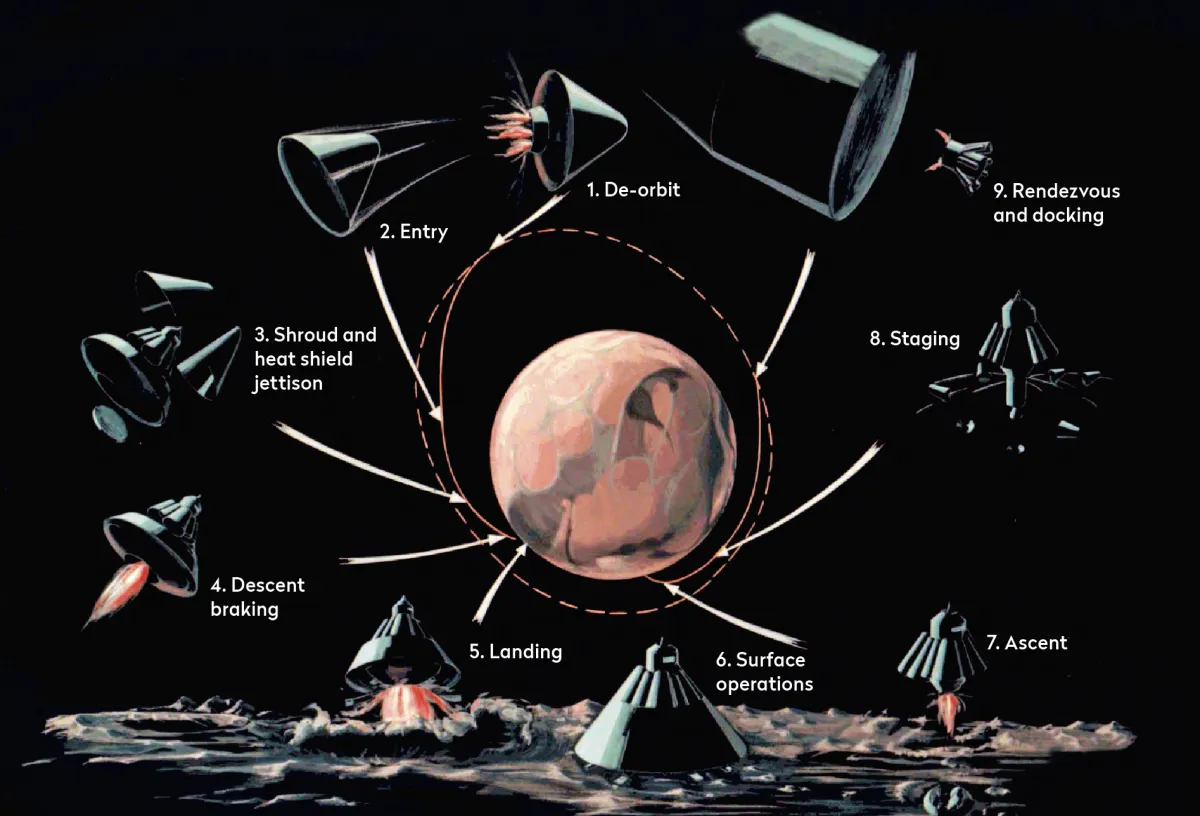
By the mid 1960s, NASA was searching for ways to use Apollo-era hardware for extended visits to the lunar surface and to support Earth-orbiting space stations throughout the 1970s.
But funds to develop these ideas never materialised and, with budgets already waning by the time the first Moon landing took place, the future of human spaceflight was in dire threat.
Radical new concepts were essential to mobilising support for a sustainable future space programme after Apollo.
As early as 1967, NASA was already moving toward replacing its expendable rockets with a reusable shuttle that would be capable of frequent flights to Earth orbit.
From there, spacecraft could launch to the Moon and Mars.
Man with a plan
By 1968 NASA realised it would have to reduce the cost of spaceflight by reusing hardware, and the concept of ‘commonality’ was added to ‘reusability’.
These became the mantra for studies conducted at NASA field centres in a search for what became known as the Integrated Space Program.
Accepted as the ultimate strategist, in 1969 von Braun devised a Mars mission plan involving four key elements.
These comprised the Saturn V, Nuclear Shuttle, Mars Mission Module and a Mars Excursion Module for a single flight to Mars and back.
It also required the availability of the Space Shuttle and continued production of the Saturn V.
The mission would begin in Earth orbit by clustering three Nuclear Shuttles in parallel: cylindrical rocket stages each using a nuclear reactor in place of a chemical combustion motor.
NASA had been studying this concept as a way of reducing the weight added by fuel, as it eliminated the heavy oxidiser.
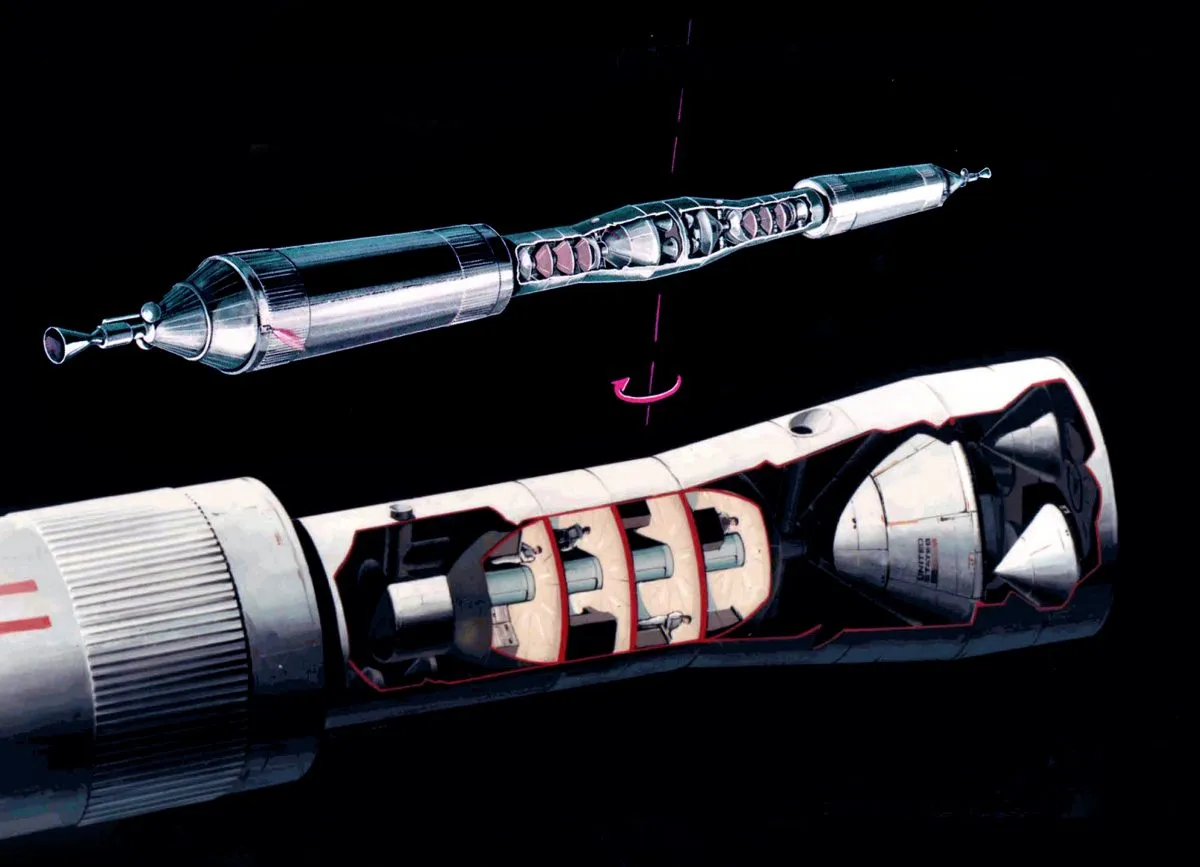
Liquid hydrogen fuel would achieve high escape velocity by passing along tubes in the hot reactor, the gases discharged through a conventional nozzle.
The Nuclear Shuttle would have a higher thrust/mass ratio than a conventional chemical rocket and accelerate a given payload to higher velocity, reducing trip time.
The central core Nuclear Shuttle would carry a Mission Module on top, to the front of which was attached the Mars Exploration Module within a protective shroud.
The two outer Nuclear Shuttle boost stages would detach after accelerating to escape velocity, returning to Earth orbit where they could be used again.
The core stage would not be fired until decelerating into Mars orbit.
Nobody knew what the effects would be of a long trip: the three crew members who would not land on Mars would be weightless for 21 months.
The weight of the Mars mission hardware was colossal.
At 82m long, the assembled vehicle would weigh 726,180kg after assembly in Earth orbit and carry a crew of six.
Von Braun wanted two ships to fly to Mars in convoy, one serving as safe haven for the crew of the second in the event that it became disabled on the way out or back.
Each Nuclear Shuttle would be 48.7m long, 10m in diameter and weigh 210,000kg.
After the outer booster stages had been jettisoned, the weight of the stack would be reduced to 306,180kg.
Nine months in space
The concept of reusable nuclear rocket stages was novel for the time.
Much as today’s SpaceX Falcon 9 core stages retain sufficient fuel to return to launch site, including firing to slow down for landing, the Nuclear Shuttle boost stages would turn around and slow down to head back for Earth orbit.
There they could be used again, after being refuelled by the winged Earth-orbit Space Shuttle.
Von Braun calculated it would take nine months to get to Mars, trading the time taken to reach the planet for a higher payload on the nuclear rocket stages.
Uncertain as to whether humans could survive that long in weightlessness, he proposed mating the two Mission Modules together, nose-to-nose, creating a rigid structure 164m in length that would spin arounda common centre for artificial gravity.
The longest space flight at the time had lasted barely two weeks, and there was already some indication of effects on the body such as a loss of calcium in the bones and muscle degradation.
Nobody knew what the effects would be of a long trip: the three crew members who would not land on Mars would be weightless for 21 months.
During the nine-month flight between Earth and Mars the crew would have lived in a spacious habitat, a cylindrical section 7.7m in diameter and 12.7m in length, a pressurised volume incorporating four decks, with access to each via a central tunnel that could serve as refuge in the event of a solar storm.
The crew would have recorded and observed the physical state of the human body, conducting astrophysical observations and a variety of experiments.
With Mars launch windows occurring at intervals of just over two years, von Braun proposed Earth departure on 12 November 1981, a date he felt was sufficiently far ahead to develop the necessary hardware at an affordable pace, with arrival in Mars orbit on 9 August 1982.

The core Nuclear Shuttle stage would decelerate the combined stack and the crew would spend around 10 weeks in Mars orbit, sending probes to the surface that would extract materials and return them to the ship, analysed and cleared of any bacteria harmful to humans.
Then the three crew members would make the trip to the surface in the Mars Excursion Module.
The cone-shaped module was capable of supporting three astronauts for 30-60 days and would have had a weight of 50,900kg before expending rocket propellant to decelerate to the surface.
Some degree of atmospheric braking would have been possible, but parachutes and a braking rocket would also have been used.
Various options were available for the size of the module, most being around 8.8m in height and 10m in diameter, with a landed weight of 37,000 kg.
Life on Mars
The Mars Excursion Module would have provided for crew comfort, access to the surface and a laboratory, although how much of that would have actually proved feasible is a moot point.
After a month or two at the surface, the upper ascent section of the MEM would carry the crew back to the orbiting cluster.
There were no plans to establish a permanent base, but a small rover would have given the crew mobility on the Red Planet.
The Mars ships would have departed for home on 28 October 1982, but the return flight would have taken the crew via Venus on 28 February 1983.
The inner planet’s gravitational pull would shave off the ship’s Earthbound velocity, reducing the speed of re-entry but also providing an opportunity to deploy probes to Earth’s twin planet.
It would be back in Earth orbit on 14 August 1983, to rendezvous with a space base which would have been established before the expedition began, with the crew returning through the atmosphere in a Space Shuttle after checks to verify they were free of Martian bugs.
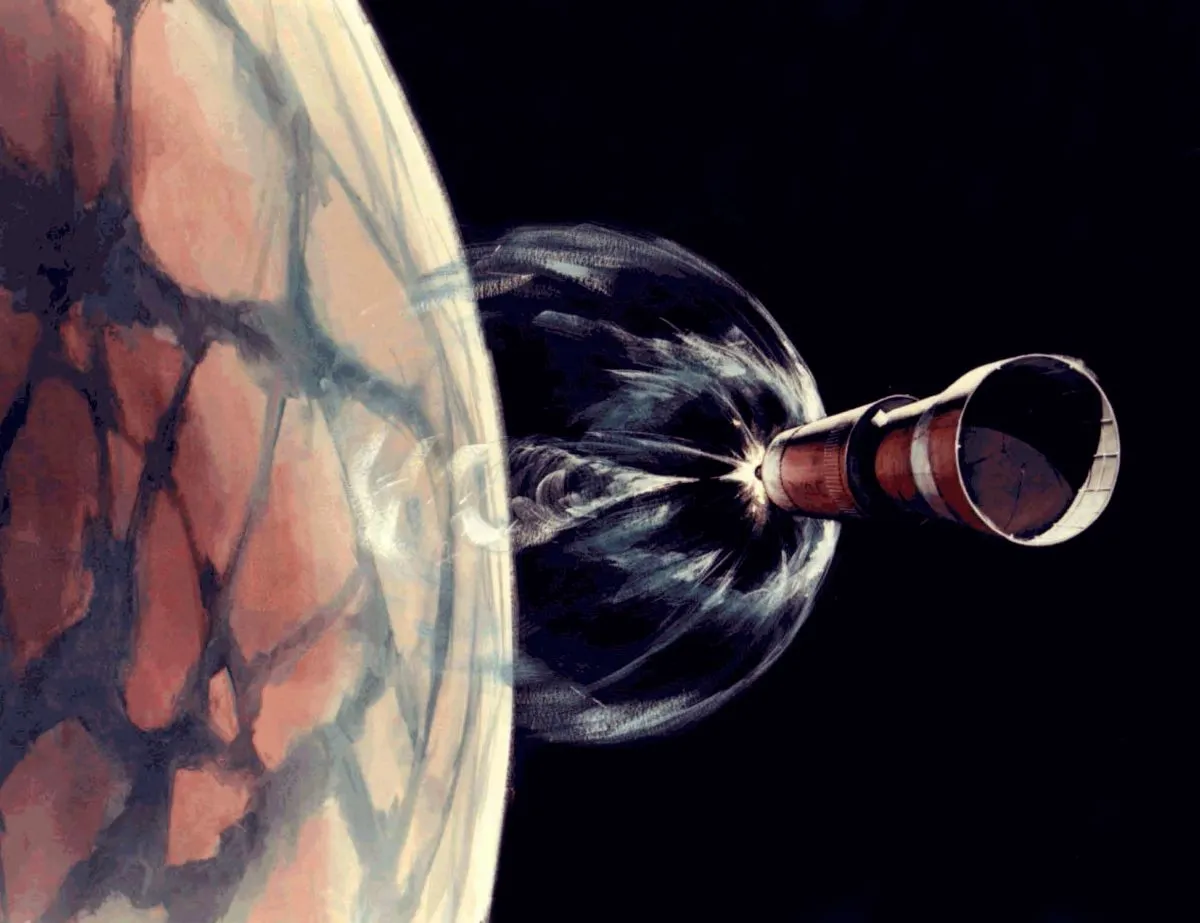
Although logcial, the Mars mission plan was ultimately flawed: it relied on technology and hardware that had yet to be developed.
The proposed Nuclear Shuttle, the Earth-orbiting space base and even the Space Shuttle were unique and without parallel or precedence.
And there was no guarantee that those propositions would have been feasible.
Undertaking von Braun’s plan would have required an ambitious expansion of NASA’s resource base, not least money, and a national commitment that had waned and did not exist in 1969.
Yet 50 years on, under Space Policy Directive 1, NASA is again planning to return to the Moon, possibly by 2024 and with a semi-permanent base by 2028.
From there, von Braun’s vision for Mars may be possible at last.
Ambition vs budget
Spacefaring nations still aspire to put boots on the Red Planet – yet astronauts have never made the perilous journey to Mars because space exploration has never received the necessary funds.
Von Braun’s Integrated Program plan of 1969 would have required NASA’s budget to double by 1974.
As it was, NASA’s budget was in decline and the Space Shuttle wasn’t approved until January 1972, on a greatly reduced budget.
Out went the Nuclear Shuttle, the space base and plans to return to the Moon, leaving only the Shuttle to begin operations in 1981.
What it had hoped to develop in parallel NASA had to place in sequence, with the space station adapted as an international venture and only emerging in the 1990s.
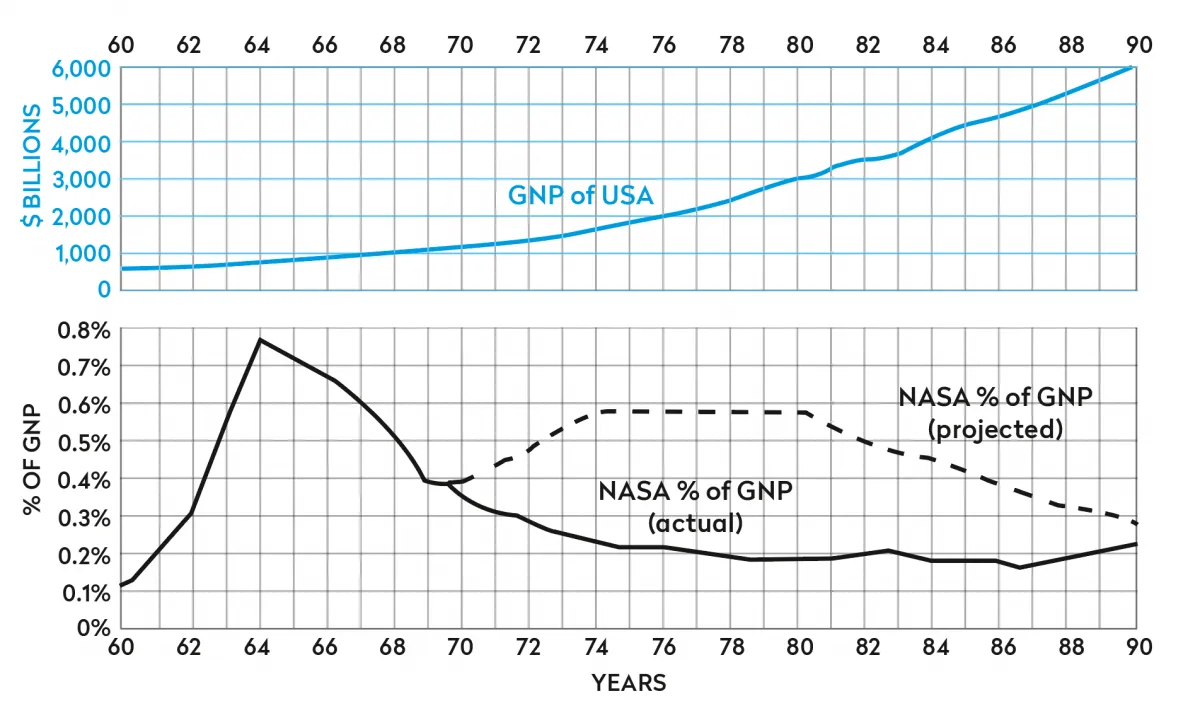
At its peak in 1965, NASA received 4 per cent of the US federal budget.
For years now, it has been barely above 0.4 per cent.
Only thanks to international cooperation and investment by private entrepreneurs is the goal now in sight.
Current plans for a return to the Moon are integral to creating a deep-space destination as a departure point for a new generation of astronauts.
Life after Apollo
Wernher von Braun never again reached the dizzy heights of putting humans on the Moon.
He had led the German rocket programme from the mid-1930s until the end of the war in 1945, before moving to the United States to help build America’s.
His engineering genius underpinned the giant Saturn rockets that took humans to the Moon and his management skills helped mobilise a team to achieve Kennedy’s moonlanding goal.
As Apollo wound down, von Braun moved to NASA headquarters, taking charge of long-range planning, but his ideas were far ahead of their time.
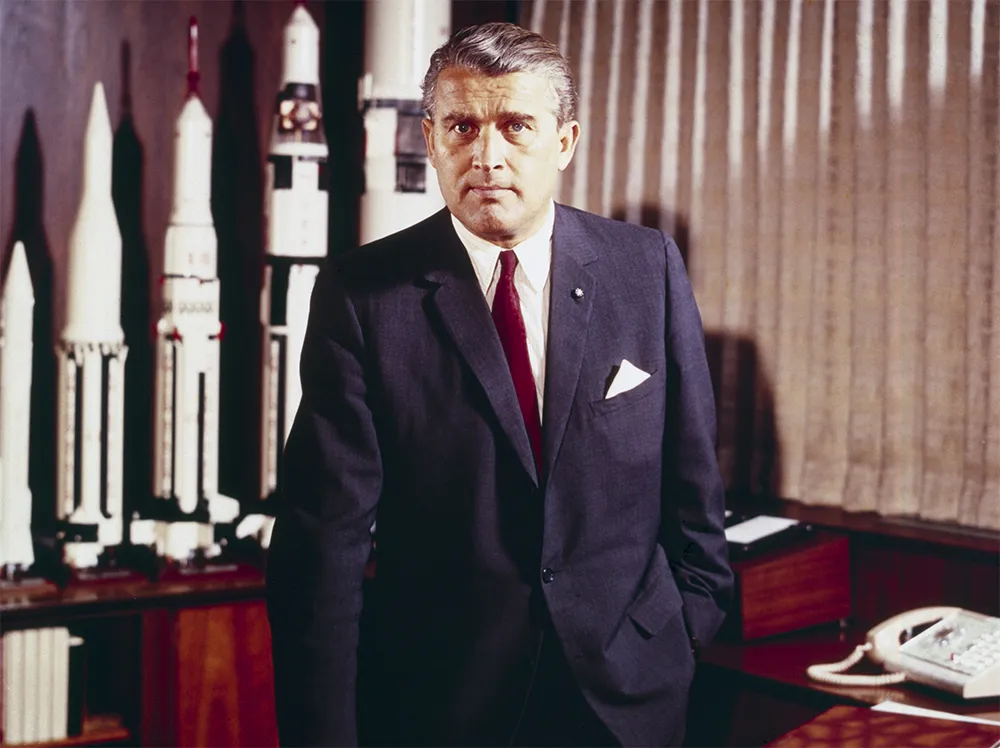
Without national commitment to fund such ambitious plans, von Braun became disillusioned and left NASA in 1972 to work for a US aerospace company.
In 1973 he was diagnosed with kidney cancer, but he continued speaking at colleges and universities, eventually helping to found the National Space Society in 1975.
Ill health caused him to retire in 1976 and he passed away in 1977, but not before being awarded the US National Medal of Science.
Von Braun was frustrated to the end that he had not been able to realise his lifetime ambition of putting humans on Mars.
This article originally appeared in the July 2019 issue of BBC Sky at Night Magazine.
David Baker is a former NASA scientist who worked on the Gemini, Apollo and Shuttle programmes. He has written over eighty books on the subject.
